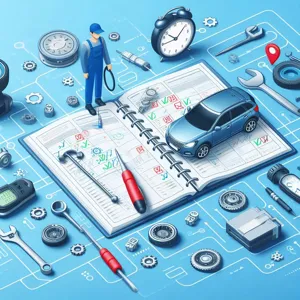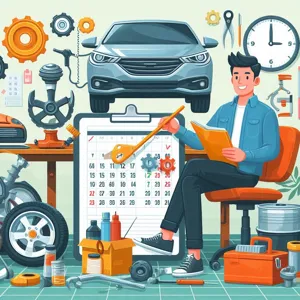In an ever-evolving automotive landscape, where innovation meets sustainability, choosing the right car has become more critical than ever.
For many drivers, investing in a vehicle is not just about immediate satisfaction; it’s about securing long-term value and reliability that can withstand the test of time. As we drive into the future, the importance of selecting a car that not only meets your driving needs but also retains its worth and performance becomes paramount. In this blog post, we’ll explore the top cars that excel in long-term value and reliability, weighing their features, performance, and cost-effectiveness. Whether you’re a seasoned car enthusiast or a first-time buyer, discover the vehicles that promise to deliver not just today, but for many years to come, ensuring peace of mind on every journey ahead.
1. Introduction: Why Long-Term Value Matters in Car Buying

When it comes to purchasing a vehicle, the allure of shiny new features, sleek designs, and cutting-edge technology can often overshadow a crucial consideration: long-term value. In a world where consumer preferences shift rapidly and market trends come and go, understanding the significance of long-term value in car buying is essential for any savvy buyer. A vehicle isn’t just a mode of transportation; it’s a significant investment that can have lasting financial implications.
Long-term value encompasses more than just the initial purchase price; it includes factors such as reliability, maintenance costs, fuel efficiency, and resale value. A car that holds its value well over the years not only provides peace of mind in terms of dependability but also safeguards your finances by minimizing depreciation. In a landscape where some vehicles lose a substantial portion of their value within the first few years, choosing a model known for longevity and reliability can lead to significant savings down the road.
Moreover, buying a car with long-term value often translates to lower overall ownership costs. Reliable vehicles tend to require fewer repairs and less frequent servicing, allowing you to avoid unexpected financial burdens. Additionally, cars that maintain their value well are often preferred by buyers in the used car market, meaning you can enjoy a higher return if and when you decide to sell.
As we delve into the top cars that epitomize long-term value and reliability, it’s essential to recognize that the choices we make today can lead to a more secure and enjoyable driving experience for years to come. In the following sections, we will explore models that not only stand the test of time but also offer a blend of performance, comfort, and economic sensibility. Buckle up as we drive into the future of car buying!
2. Understanding Reliability Ratings: What to Look For
When it comes to investing in a vehicle that will stand the test of time, understanding reliability ratings is crucial. These ratings can often make or break your decision, guiding you toward models that promise not only longevity but also peace of mind on the road. But what exactly should you be looking for when diving into these ratings?
First and foremost, pay attention to the sources of the reliability ratings. Reputable organizations such as J.D. Power, Consumer Reports, and the National Highway Traffic Safety Administration (NHTSA) provide comprehensive surveys and data on vehicle performance over time. These sources analyze owner feedback and extensive testing to compile reliable statistics, which can serve as a solid foundation for your research.
Look for specific metrics within these ratings—like the frequency of repairs, the cost of ownership, and the average lifespan of vehicles. A car that may have a slightly lower initial reliability rating could still offer exceptional long-term value if it requires fewer repairs and has a reputation for holding up well over time.
Additionally, consider the model’s historical reliability. Some brands have built a legacy around dependable vehicles that consistently perform well across generations. Investigating previous years’ ratings can provide insight into whether a particular model is an outlier or part of a broader trend of reliability.
Lastly, don’t overlook the importance of warranty information. A robust warranty can be an indicator of a manufacturer’s confidence in their vehicle’s reliability. Extended warranties can also provide extra reassurance, allowing you to enjoy your car without the anxiety of unexpected repair costs.
By keeping these factors in mind, you can make an informed decision that aligns with your long-term goals, ensuring that the car you choose not only meets your immediate needs but also serves you well for years to come.
3. Factors Affecting Long-Term Value

When it comes to determining the long-term value of a car, several critical factors come into play that prospective buyers should consider. Understanding these elements not only aids in making an informed purchase but also helps in predicting how well a vehicle will retain its value over time.
**1. Brand Reputation:** Certain brands have established a reputation for reliability and durability, which significantly influences resale value. Brands like toyota, Honda, and Subaru are often heralded for their longevity and dependability, making their vehicles highly sought after in the used car market. A strong brand reputation can not only ensure that your car retains its value but can also make it easier to sell when the time comes.
**2. Maintenance History:** A well-documented maintenance history can dramatically affect a vehicle’s long-term value. Cars that have been regularly serviced and properly cared for tend to retain their value better than those with a patchy maintenance record. When shopping for a used vehicle, always inquire about its service history and consider investing in a pre-purchase inspection to ensure it has been maintained correctly.
**3. Mileage:** Mileage is a key indicator of a vehicle’s wear and tear, and generally, the lower the mileage, the higher the potential resale value. However, it’s essential to consider not just the number of miles driven but also the type of driving. Highway miles are less taxing on a vehicle than city miles filled with stop-and-go traffic, hence a car with mainly highway mileage may still hold its value well despite a higher overall count.
**4. Vehicle Condition:** The overall condition of the car, both mechanically and aesthetically, plays a significant role in its long-term value. Regular cleaning, timely repairs, and addressing cosmetic issues can enhance a vehicle’s appeal. A well-maintained exterior and interior can make a substantial difference when it comes time to sell or trade in.
**5. Features and Technology:** Modern features and technology can boost a car’s long-term value. Vehicles equipped with advanced safety features, fuel-efficient engines, and infotainment systems that remain relevant over time are more likely to appeal to future buyers. As the automotive market evolves, cars that offer desirable technology will continue to attract interest.
**6. Market Trends:** Economic factors, fuel prices, and shifts in consumer preferences significantly impact the automotive market. For example, the rising demand for electric vehicles (evs) has changed the landscape of long-term value. Understanding these trends can provide valuable insights into which vehicles may be more likely to hold their value in the future.
By considering these factors, car buyers can make informed decisions that not only satisfy their immediate transportation needs but also ensure they are investing in a vehicle with sustained long-term value and reliability. In a world where cars are more than just a means of transportation, it’s essential to choose wisely for both present satisfaction and future returns.
4. Top Brands Known for Reliability
When it comes to choosing a vehicle that will stand the test of time, reliability is key. Certain brands have built a solid reputation over the years for producing cars that not only hold their value but also deliver dependable performance mile after mile. Here, we delve into some of the top brands known for their reliability, so you can make an informed decision when driving into the future.
**1. Toyota:** Renowned for its remarkable engineering and long-lasting vehicles, Toyota consistently ranks at the top of reliability lists. Models like the Camry and Corolla are celebrated for their enduring performance and low maintenance costs. Toyota’s commitment to quality is evident in its robust lineup, which often includes hybrid and fuel-efficient options, making it a smart choice for eco-conscious drivers.
**2. Honda:** Another titan in the automotive world, Honda is synonymous with reliability and resale value. With models like the Civic and Accord, Honda has mastered the art of producing vehicles that blend performance with practicality. Owners often praise these cars for their smooth handling and longevity, making them an ideal choice for those looking to invest in a vehicle that will last.
**3. Subaru:** Known for its all-wheel-drive technology and rugged capabilities, Subaru has cultivated a loyal fan base, particularly among outdoor enthusiasts. Models such as the Outback and Forester not only offer reliability but also safety and versatility. Subaru’s commitment to engineering durable vehicles makes them an excellent option for those who seek adventure without compromising dependability.
**4. Lexus:** For those who desire luxury without sacrificing reliability, Lexus shines brightly. As Toyota’s luxury division, Lexus cars inherit the brand’s reputation for durability while offering a premium experience. With impeccable craftsmanship and high-quality materials, models like the ES and RX provide peace of mind alongside opulence, making them smart long-term investments.
**5. Mazda:** Merging reliability with driving enjoyment, Mazda has earned accolades for its innovative design and spirited performance. The Mazda3 and CX-5 are particularly noted for their fun-to-drive nature paired with dependable engineering. Mazda’s focus on quality ensures that you won’t just enjoy the ride today but also for years down the road.
When selecting your next vehicle, considering these brands will put you on the right path toward a purchase that promises long-term value and reliability. Each of these manufacturers boasts a track record of building cars that withstand the test of time, providing peace of mind and driving enjoyment for countless miles ahead.
5. Sedans: Best Long-Term Value Options

When it comes to long-term value and reliability, sedans have carved out a niche that marries practicality with performance. These vehicles often offer a balanced combination of comfort, efficiency, and affordability that appeals to a wide range of drivers, making them a smart investment for those looking to maximize their returns over time.
One standout option in the sedan category is the Toyota Camry. Renowned for its longevity and low maintenance costs, the Camry is a favorite among consumers who prioritize reliability. With its consistently high resale value and a reputation for dependability, this sedan is a quintessential choice for anyone looking to keep their vehicle for the long haul.
Another strong contender is the Honda Accord. Known for its spacious interior and smooth ride, the Accord not only provides comfort but also boasts impressive fuel efficiency. Its blend of advanced technology and safety features ensures that you’re getting a vehicle that’s both modern and reliable, making it a wise investment for the future.
If you’re leaning towards something more luxurious, the BMW 3 Series deserves a mention. While it may come with a higher upfront cost, its resale value tends to hold strong, particularly if you maintain it well. The 3 Series offers a driving experience that’s hard to match, with a reputation for performance and style that appeals to enthusiasts and everyday drivers alike.
Lastly, the Hyundai Sonata is becoming increasingly popular for those seeking long-term value. With an impressive warranty and a strong track record for reliability, the Sonata is an excellent choice for buyers who want a sedan that won’t break the bank in terms of maintenance and repairs.
In conclusion, when considering a sedan for long-term value, it’s essential to factor in not only the purchase price but also the reliability, maintenance costs, and resale value. By choosing models like the Toyota Camry, Honda Accord, BMW 3 Series, or Hyundai Sonata, you can feel confident that your investment will continue to pay dividends for years to come. As you drive into the future, these sedans stand out as smart choices for anyone looking to balance comfort, efficiency, and long-term reliability.
6. SUVs: Reliable Choices for Families
When it comes to family vehicles, SUVs have carved out a prominent niche for themselves, not just for their spacious interiors but also for their reputation for reliability and long-term value. In today’s fast-paced world, families require a vehicle that can adapt to their changing needs, and SUVs are designed with this flexibility in mind. With ample cargo space, comfortable seating, and advanced safety features, they cater to everything from school runs to weekend getaways.
One of the standout qualities of SUVs is their robust build and durability. Many models are engineered to withstand the rigors of daily family life, from the inevitable spills and stains to the occasional rough handling. Brands like Toyota and Honda have long been champions of reliability, consistently producing SUVs that retain their value over the years. The Toyota RAV4 and Honda CR-V, for instance, are not only fuel-efficient but also boast high resale values, making them smart long-term investments.
Moreover, the advancements in technology and safety features in modern SUVs further enhance their appeal. Most come equipped with cutting-edge infotainment systems, adaptive cruise control, lane departure warnings, and various driver-assistance features that provide an extra layer of security for families on the road. These innovations not only contribute to the overall driving experience but also ensure peace of mind for parents.
In addition to practicality, many SUVs offer impressive performance capabilities. Whether you’re navigating the urban jungle or embarking on outdoor adventures, a reliable SUV provides the confidence to tackle diverse terrains and driving conditions. With options ranging from all-wheel drive to enhanced towing capacities, families can explore more without the worry of compromising on reliability.
In summary, if you’re in the market for a family vehicle that combines reliability, long-term value, and versatility, SUVs stand out as an excellent choice. Their capacity to adapt to your family’s evolving needs while delivering on performance and safety makes them a wise investment for the future. As you drive into the future, consider adding an SUV to your lineup—it’s a decision that your family will appreciate for years to come.
7. Trucks: Longevity and Performance

When it comes to longevity and performance, few vehicles can rival the rugged reliability of trucks. Built to withstand the demands of heavy-duty use, trucks have become synonymous with durability, making them an excellent investment for those who value both performance and long-term value.
The modern truck is engineered not just for strength, but also for comfort and technology, catering to a diverse range of drivers—from hardworking tradespeople to adventure-seekers. Brands like Ford, Chevrolet, and Toyota have consistently topped the charts for reliability, with models such as the Ford F-150, Chevrolet Silverado, and Toyota Tundra leading the pack. These vehicles are designed to endure long miles and tough conditions, often boasting impressive towing capacities and payloads that cater to both work and play.
Moreover, the resale value of trucks tends to hold steady over the years. Their versatility makes them appealing to a broad audience, from families needing extra space to outdoor enthusiasts hauling gear. The robust demand for used trucks means you can expect a good return on your investment if you decide to sell down the line.
In addition to their physical toughness, many modern trucks are equipped with advanced technology that enhances safety, connectivity, and driving experience. Features such as adaptive cruise control, lane-keeping assist, and advanced infotainment systems make these vehicles not only capable but also enjoyable to drive.
Choosing a truck can provide peace of mind; with regular maintenance, these vehicles often run well into the hundreds of thousands of miles. So whether you’re navigating city streets or tackling off-road trails, investing in a truck means you’re driving into a future filled with reliability and exceptional performance.
8. Electric Vehicles: Future-Proofing Your Investment
As the automotive landscape undergoes a transformative shift, electric vehicles (EVs) are rapidly emerging as a cornerstone of tomorrow’s transportation. Investing in an EV not only aligns with a more sustainable future but also offers long-term value and reliability that traditional combustion engine vehicles may struggle to match.
One of the most compelling reasons to consider an electric vehicle is the remarkable efficiency that these cars boast. With fewer moving parts compared to their gasoline counterparts, EVs generally require less maintenance, translating to lower long-term ownership costs. Plus, the absence of oil changes and a simpler drivetrain means that you can spend less time at the mechanic and more time enjoying the open road.
In addition to financial benefits, electric vehicles are also becoming increasingly popular among consumers, which translates to higher resale values. As more drivers recognize the benefits of going electric, the demand for used EVs is on the rise, making them a smart investment for the future. Brands like Tesla, Nissan, and Chevrolet have established themselves in this market, and their vehicles consistently hold their value well over time.
Moreover, with government incentives and rebates for EV purchases becoming more commonplace, the upfront costs are becoming more manageable. Many states offer tax credits, while some manufacturers provide financial incentives for trading in older, less efficient vehicles. This not only reduces the initial purchase price but also encourages a more eco-friendly driving experience.
As infrastructure for charging continues to expand—making it easier for EV owners to charge their vehicles at home, work, or on the go—the convenience factor grows significantly. Innovations in battery technology are also enhancing the range of electric vehicles, alleviating the “range anxiety” that early adopters once faced. With advancements in fast-charging stations popping up across cities and highways, long-distance travel in an electric vehicle has become more feasible than ever before.
In conclusion, choosing an electric vehicle is not just a nod to environmental responsibility; it’s a forward-thinking approach to car ownership. With their increasing reliability, lower maintenance costs, and strong resale values, EVs are undoubtedly a smart choice for anyone looking to future-proof their investment in the ever-evolving world of automobiles. Embrace the change, and drive into a greener, more sustainable future that promises long-term rewards.
9. Hybrid Cars: The Best of Both Worlds
In an era where sustainability and efficiency reign supreme, hybrid cars have emerged as a compelling choice for consumers seeking the best of both worlds. These vehicles combine the traditional internal combustion engine with an electric motor, allowing for reduced fuel consumption and lower emissions without sacrificing performance. With rising fuel prices and increased environmental awareness, hybrids represent a savvy investment that promises long-term value and reliability.
One of the most attractive features of hybrid vehicles is their exceptional fuel economy. Many models achieve impressive miles per gallon (MPG) ratings, making them ideal for daily commutes and long road trips alike. For those who frequently navigate urban environments, the ability to drive on electric power at lower speeds translates into significant savings at the pump, allowing you to stretch your dollar further.
In addition to their economical advantages, hybrid cars are engineered with longevity in mind. Manufacturers have invested heavily in the technology behind hybrids, leading to advancements that enhance both the durability of the vehicle and the lifespan of its components. Most notably, the battery systems in hybrids have improved significantly over the years, with many models now boasting warranties that stretch well into the eight- to ten-year range. This means that buyers can enjoy peace of mind knowing that their investment is protected for a substantial period.
Moreover, hybrids often come equipped with a host of modern features aimed at enhancing both the driving experience and safety. From advanced driver-assistance systems to state-of-the-art infotainment systems, these vehicles cater to tech-savvy consumers while ensuring a comfortable and secure ride.
As governments around the world continue to push for greener alternatives, hybrid cars are likely to retain their value in the marketplace. With incentives such as tax breaks and rebates often available to hybrid owners, the initial investment can become even more attractive. In summary, if you’re seeking a vehicle that marries reliability with eco-friendly benefits, hybrid cars are undeniably a smart choice as we drive into the future. Their blend of efficiency, performance, and longevity makes them a top contender for those looking to maximize their investment while minimizing their environmental footprint.
10. How Maintenance Impacts Long-Term Value
When it comes to the long-term value and reliability of a vehicle, maintenance plays a pivotal role that cannot be overstated. Regular upkeep not only ensures your car runs smoothly but also significantly affects its resale value when the time comes to upgrade. A well-maintained vehicle is often viewed as a testament to careful ownership, instilling confidence in potential buyers and allowing you to command a higher price.
Routine maintenance tasks—such as oil changes, tire rotations, and brake inspections—are your first line of defense against substantial mechanical issues down the road. Neglecting these simple yet essential services can lead to costly repairs that diminish your car’s value and reliability. For instance, failing to replace worn-out brakes can result in additional damage to the rotors, leading to more extensive repairs that could have been easily avoided with timely maintenance.
Furthermore, keeping detailed records of all maintenance performed on your vehicle can significantly enhance its appeal to buyers. A comprehensive service history demonstrates that the car has been cared for, which is particularly attractive in a market flooded with options. Buyers are more likely to trust a vehicle that has a transparent maintenance record, leading to quicker sales and higher offers.
In addition, some manufacturers offer service packages that include scheduled maintenance for a set period. Taking advantage of these packages can not only save you money over time but also ensure that your vehicle receives the necessary care it requires to maintain its reliability and value.
In essence, committing to regular maintenance is not just about keeping your vehicle in peak condition; it’s an investment in its long-term value. By prioritizing maintenance, you can enjoy peace of mind knowing that your car will serve you well for years to come while also retaining a significant portion of its value when it’s time to sell or trade in. Remember, a car is not just a mode of transportation—it’s an investment that deserves your attention and care.
11. Resale Value: What to Expect as Prices Shift
When considering the long-term value of a vehicle, understanding its resale value is critical, especially in a market that fluctuates with economic trends, consumer preferences, and technological advancements. Resale value refers to the amount you can expect to receive when selling or trading in your car, and it can significantly impact your overall investment in a vehicle.
As prices shift—due to factors such as supply chain disruptions, fuel prices, and the growing popularity of electric vehicles—certain brands and models have consistently shown resilience in holding their value over time. For instance, vehicles from manufacturers known for their reliability, like Toyota and Honda, often command higher resale prices. Meanwhile, luxury brands may experience sharper depreciation in the first few years but can stabilize at higher resale values if they maintain a reputation for quality and prestige.
It’s also essential to consider the vehicle’s segment. SUVs and trucks are currently in high demand, often leading to better resale values compared to sedans. Additionally, limited editions or models with unique features may also see an increase in value as collectors and enthusiasts seek them out.
To navigate shifting prices wisely, research historical resale trends, monitor market conditions, and consult resources like Kelley Blue Book or Edmunds, which provide valuable insights into what you can expect when it’s time to sell. By choosing a car with a strong resale value and understanding the factors that influence it, you’ll not only make a sound investment but also enjoy peace of mind as you drive into the future.
12. Customer Reviews: Real-World Reliability Insights
When it comes to assessing the long-term value and reliability of a vehicle, customer reviews serve as a crucial resource. These firsthand accounts from actual owners provide invaluable insights that go beyond the polished specifications and marketing slogans. Real-world experiences reveal how cars perform under various conditions, from daily commutes to long road trips, and can highlight potential issues that might not be evident during a quick test drive.
Take, for instance, the Toyota Camry, a perennial favorite among consumers for its dependable nature. Many owners rave about its longevity, with some reporting trouble-free ownership well beyond the 200,000-mile mark. Similarly, Subaru Outback enthusiasts often share stories of their vehicles tackling rugged terrains and inclement weather, underscoring the brand’s reputation for reliability and safety.
On the other hand, customer reviews can also serve as cautionary tales. For example, potential buyers might discover recurring complaints about certain features or components in a model, such as transmission issues or electronic malfunctions. These insights can help you steer clear of vehicles that may have hidden pitfalls, ultimately saving you from costly repairs and frustrations down the road.
In this age of digital communication, platforms like Yelp, Google Reviews, and automotive forums provide a wealth of information that can help guide your decision-making process. By taking the time to read through these reviews, you’ll gain a clearer picture of what to expect from a vehicle over the long haul. Remember, the real-world reliability of a car is often best understood through the voices of those who have navigated the twists and turns of ownership—making customer reviews an essential part of your research as you drive into the future.
13. Tips for Choosing a Car with Long-Term Value
When it comes to choosing a car with long-term value, the decision extends far beyond mere aesthetics or the latest tech features. It requires a careful consideration of several factors that contribute to reliability and enduring worth. Here are some essential tips to guide you on your journey to finding a vehicle that will stand the test of time.
**1. Research Reliability Ratings:** Before you even step foot in a dealership, do your homework. Check resources like Consumer Reports and J.D. Power for reliability ratings of various models. These ratings can provide valuable insights into which cars consistently outperform others in terms of durability and maintenance costs.
**2. Consider Ownership Costs:** A car’s price tag is just the beginning. Factor in insurance, fuel efficiency, and maintenance costs. Brands known for their longevity, such as Toyota and Honda, often have lower overall ownership costs due to their reliable performance and fewer repairs over time.
**3. Look for Proven Models:** Certain models have established a reputation for reliability over the years. Opt for vehicles that have stood the test of time, as these are more likely to maintain their value. Iconic models like the Subaru Outback or Honda Civic are often cited as great choices for those seeking long-term reliability.
**4. Evaluate Safety Ratings:** A car that is safe not only protects you and your passengers but can also retain its value longer. Cars with high safety ratings tend to appeal to a broader audience when it’s time to sell or trade in. Be sure to check the National Highway Traffic Safety Administration (NHTSA) and the Insurance Institute for Highway Safety (IIHS) for comprehensive safety ratings.
**5. Assess the Warranty:** A robust warranty can greatly enhance your peace of mind. Look for manufacturers that offer extended warranties or powertrain coverage, which can save you significant costs on repairs and maintenance during the early years of ownership.
**6. Test Drive and Inspect:** Finally, never underestimate the importance of a thorough test drive and inspection. Your personal experience with a vehicle’s comfort, handling, and features can heavily influence your satisfaction and longevity with the car. Additionally, consider having a trusted mechanic inspect any used vehicle to ensure there are no hidden issues.
By taking the time to consider these factors, you’ll be well-equipped to choose a car that not only meets your immediate needs but will also provide you with long-term value and reliability for years to come. Your future self will thank you for making a thoughtful decision today!
14. Conclusion: Making an Informed Decision
In conclusion, making an informed decision when selecting a car for long-term value and reliability is crucial in today’s automotive landscape. As we’ve explored throughout this blog, understanding the nuances of various makes and models can significantly impact your ownership experience and financial investment.
When you prioritize reliability, you not only safeguard your wallet from unexpected repair costs but also ensure peace of mind on the road. Whether you’re drawn to the timeless dependability of a Honda Civic, the rugged durability of a Toyota Tacoma, or the innovative engineering of a Tesla, each vehicle has its unique strengths that cater to different lifestyles and preferences.
Before you make your final choice, take the time to research and test drive your options. Consider the vehicle’s history of performance, customer reviews, and expert ratings, all of which can provide valuable insights into what you can expect over the years. Additionally, think about your personal needs—how often will you be driving? What conditions will you face?
Remember, a well-informed decision today can lead to a rewarding ownership experience tomorrow. As you navigate the exciting journey of car shopping, keep these insights in mind, and you’ll be well on your way to finding a vehicle that not only holds its value but also enhances your daily life. Here’s to driving into a future filled with reliability, comfort, and value!
15. Resources for Further Research on Car Reliability and Value
When it comes to making an informed decision about your next vehicle purchase, having access to reliable resources can make all the difference. Understanding car reliability and long-term value isn’t just about picking a popular model; it’s about digging deeper into data and insights that reflect real-world performance and ownership experiences. Here are some top resources that can guide you in your research:
1. **Consumer Reports**: Renowned for its rigorous testing and unbiased reviews, Consumer Reports provides detailed assessments of vehicle reliability based on extensive surveys from real owners. Their annual vehicle reliability survey is a goldmine for prospective buyers, offering insights into issues faced by specific makes and models.
2. **J.D. Power**: Known for its customer satisfaction surveys, J.D. Power also publishes annual reports on vehicle dependability and initial quality. Their studies focus on real-world experiences and can help you gauge how well a car holds up over time.
3. **Edmunds**: This comprehensive automotive resource is invaluable for its detailed reviews, long-term test drives, and expert buying advice. Edmunds also includes user reviews that can provide a broader spectrum of experiences from everyday drivers.
4. **Kelley Blue Book (KBB)**: KBB is not only a trusted source for vehicle pricing but also offers insights into resale values and vehicle ratings. Their Best Resale Value Awards highlight cars that retain their worth over time, making it a useful tool for those looking to invest wisely.
5. **National Highway Traffic Safety Administration (NHTSA)**: The NHTSA’s database offers a wealth of information regarding safety ratings and recalls. Prioritizing safety can significantly enhance a vehicle’s long-term value, making this resource particularly important.
6. **CarComplaints.com**: For a more consumer-driven perspective, CarComplaints.com aggregates data on reported problems from actual vehicle owners. This site allows you to search by make and model to identify common issues, giving you a clearer picture of potential pitfalls before you buy.
7. **Forums and Owner Groups**: Online forums and social media groups dedicated to specific makes and models can provide real-time insights from passionate owners. These communities often share tips, experiences, and advice that aren’t found in formal reviews, and they can be a treasure trove of information.
8. **Local Dealerships and Certified Mechanics**: Don’t underestimate the value of talking to professionals who work with cars daily. Local dealerships and trusted mechanics can offer insights into which models are known for reliability and which might be prone to issues. They often have firsthand knowledge of long-term performance based on the vehicles they service.
By leveraging these resources, you can empower yourself with the knowledge needed to make a sound investment in your next vehicle. Researching reliability and long-term value not only helps in choosing the right car but also ensures that your choice stands the test of time, providing you with peace of mind and continuous satisfaction on the road ahead.
As we navigate the ever-evolving landscape of the automotive industry, investing in a vehicle that promises long-term value and reliability is more crucial than ever. In this article, we’ve explored some of the top contenders that not only stand the test of time but also deliver exceptional performance and peace of mind for years to come. By considering factors such as resale value, maintenance costs, and durability, you can make an informed decision that keeps both your finances and your driving experience in check. Whether you’re a first-time buyer or a seasoned car enthusiast looking to add a reliable gem to your collection, the options we’ve discussed will undoubtedly steer you in the right direction. Here’s to making wise choices today that will keep you confidently driving into the future!




































